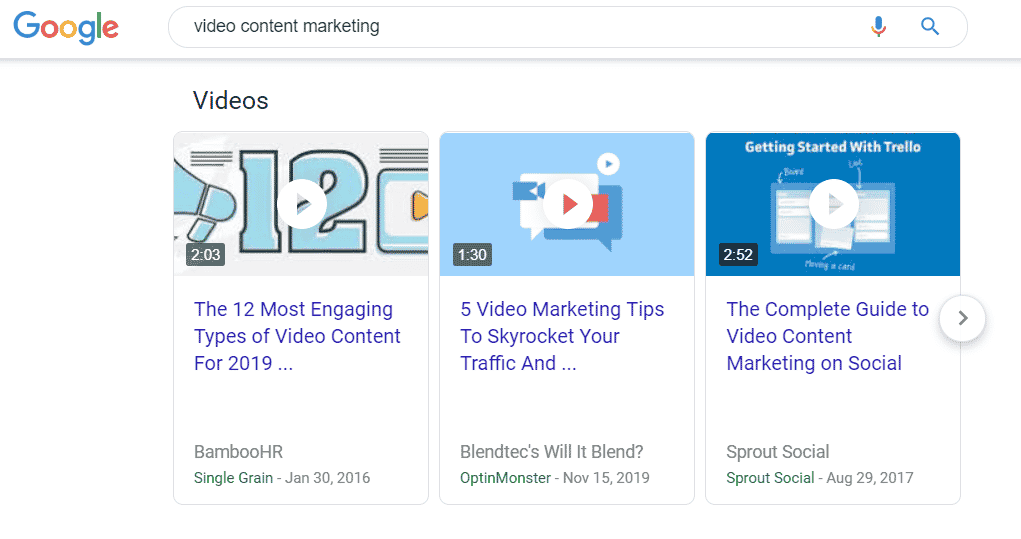Everyone wants to get their video on the first page of Google search results. That coveted first-page placement means more views for your video, more traffic for your site, and, ideally, more sales for your business. If you can snag the video snippet—the video result that sometimes pops up at the top of the page—all the better. Improving your Google search ranking isn’t easy but video SEO may give you more control over where your video ranks than you think.
Google hasn’t always been completely transparent when it comes to explaining how websites are ranked. To make matters more confusing, the factors that matter for a text-based page (like this blog post for example) are different than those for video SEO. Many marketers give up before they even get started because they don’t understand the steps they need to take.
Achieving first-page status or even a video snippet is possible. The following seven best practices will help tip the odds in your favor.
Why The First Page of Google Search Results?
Improving your content to help it rank high on search engines is known as search engine optimization or SEO. Video SEO is a similar process for your video content. Since Google accounts for more than 90% of worldwide search volume, it’s worth focusing on that search engine specifically.
First a disclaimer: No amount of video SEO wizardry can guarantee that your video will absolutely make it to the first page of the Google search results. However, if you take the right actions, you can significantly improve your chances.
Here’s a sobering statistic: 75% of users never scroll past the first page of search results, according to Hubspot. So if your video isn’t showing up on the first page of Google search results, it might as well not show up at all.
Fortunately, Google search placement is governed by something slightly more predictable than random chance. It’s based on about 200 Google search ranking factors. We don’t need to get into all of them here. Some are deeply technical and others are out of your control. Instead, we’ll focus on a few key factors that you can manage yourself.
Where Does Video Show Up In Search?
As video has become more popular over the last few years, the competition for that coveted first page video result has become more fierce. At the same time, Google has introduced new ways for people to discover videos.
You may spot video results in a carousel at the top of your search engine results page (SERP). This area showcases those videos that Google thinks are most relevant to your search. The carousel isn’t always present and it isn’t always at the top of the page. Depending on your search terms, it might not appear at all. You can also click the video tab on any SERP to see only video results.
Perhaps the most coveted position in Google Search results is the featured snippet. These brief excerpts appear at the very top of the search results and are chosen based on how concisely they answer the user’s question. Most often they are text results, but sometimes, Google will serve up a specific section of a video. Featured video snippets are most likely to appear in response to a “how to” query. To get the snippet below, we searched for “how to draw a rocket”.
Keep in mind that featured snippets are chosen entirely by the Google algorithm. You can’t control whether Google thinks a search query deserves a snippet. What you can do, is create a focused video that answers a single question. Then include a timestamped transcript, usually in the form of an SRT file. This will increase your odds of being featured.
The takeaway is that ranking on Google video search isn’t an exact science, but with the right video SEO tactics, you can at least make sure your video has a fighting chance.
How To Get Video To Page One of Google Search Results
To improve your video SEO, you need some understanding of how Google ranks and indexes pages. In the most basic terms, Google sends a piece of code known as a web crawler to scan through your website and gather information about it.
You can imagine a web crawler as an associate in a massive DVD warehouse. His job is to tag each video so he can quickly find the ones customers ask for. If the associate does his job well, a customer can say, “Bring me cat videos,” and the associate can quickly pull a dozen cat videos for the customer to peruse.
That makes sense so far, but here’s where it gets tricky. The associate doesn’t have a DVD player, so he can’t watch the videos. Instead, he has to rely on the information written on the DVD case to organize the collection. Oh, and every minute people bring him hundreds of videos to catalog.
In the same way, web crawlers investigate the text on your website for information about your videos. If your title doesn’t make sense, your description is missing information, or there isn’t enough copy on the page. The associate, I mean web crawler, won’t know how to categorize your video and it will get pushed way down the list of search results.
On the other hand, if all of your information is in order, the web crawler can quickly understand what your video is about and you’ll be able to rank higher. Here are seven ways to improve your odds of reaching first-page rank on Google search results:
1. Get Smart About Hosting
Where you host your video changes how you’ll be indexed. Some hosting sites automatically include metadata to facilitate site indexing, while others require you to insert this information manually. If you’re not a professional web developer, that process can be difficult and time consuming. Look for a host that takes care of your video schema. Wistia, YouTube and Vimeo all fit the bill.
As you consider your hosting options, you may hear some experts claim that it’s a lot harder to get self-hosted videos to rank, because Google owns YouTube and has an interest in promoting YouTube results first. And that’s probably true when it comes to video snippets. If you’re aiming for a featured snippet spot you should probably host your video on YouTube. Google hasn’t specifically said that videos hosted in other places can’t be featured snippets, but we haven’t found any examples to the contrary.
Any relevant video can rank in other places on Google, even if it’s not posted on YouTube, as long as you have strong SEO. To prove it, here’s what I got when I typed “Video Content Marketing” into my Google search. Notice that none of these videos are hosted by YouTube.
If your goal is to increase awareness of your product or service, YouTube is a fine place to host your videos. However, if your goal is to drive traffic to your website, YouTube might not be the best choice.
2. Include Transcripts to Boost Video SEO
Remember, web crawlers can read, but they can’t view videos. So including a transcript massively increases the amount of data the web crawler can access. All of that extra information helps them match your video with the search terms most relevant to it. Including timestamps in your transcript will increase the odds that Google will serve a section of your video as a featured snippet.
Planned videos have scripts, which you can easily publish underneath your video. For live videos, creating a transcript will add time and expense. If you don’t have the resources to make a transcription, at least include a well-written summary that references relevant keywords. The web crawler will still be able to find useful information.
A note about captions: Since web crawlers can’t watch your video, they can’t read captions either. At least, not open or autogenerated captions. If you upload “closed captions” as an SRT file, the web crawler views these as text. Ask your video creation company for a Subrip or SRT file for the best video SEO. If you do use autogenerated captions, they can still contribute to your video SEO by improving the viewing experience. The better the experience, the longer viewers will spend watching your video. Increased watch time naturally boost your SEO. So include captions whenever you can.
3. Invite A Click
Google takes view rates and clicks into account, so make sure people actually want to click on your video. Choose a thumbnail that is inviting and as relevant as possible. Smiling faces are always a good choice. Your hosting platform might auto-generate a thumbnail for you, but you don’t have to use it. Instead, comb through your video to find an image that truly conveys what the video is about. You can also create a custom thumbnail that includes a text overlay, several scenes from the video, or anything else you can fit in a graphic.
Your descriptions and title should also be inviting. The user should know at a glance exactly what the video is about and whether it’s relevant to them. Be creative, but make sure that whatever your title promises your video delivers. So if you promise 7 tips for ranking on the first page of Google, you must have seven tips and they must be about Google ranking. Otherwise, people will bail out before the end of your video, and that’s bad for your ranking.
4. Use Keywords to Boost Video SEO
We’ve touched on this in some of the tips above, but it’s important enough to get its own section: Use keywords in your title, description, and any accompanying page copy. Just as you would research keywords for a blog post, you should also research and use keywords in the copy surrounding your video. Keywords should be relevant to the video and reflect user search patterns.
However, don’t get so wrapped up in keywords that you forget who you’re writing for. Yes, the web crawler needs to understand what your video is about, but so do users. Use correct grammar and spelling. Most importantly, avoid using the keyword over and over in an attempt to sound relevant. That’s called keyword stuffing, and search engines are on to that trick. It won’t fool users either.
5. Promote Your Video
Video views have a compounding effect on ranking. The more views your video gets, the more popular it appears, and the higher it will rank. The higher it ranks, the more people are likely to discover it, improving rank even more. Give your video a leg up by promoting it as much as you can. Send it out in email, link to it in a blog post, and share it across your social media platforms.
If you have the budget, you might also invest in social or search ads to direct traffic to your video. Building relationships with other blogs and websites may also help improve SEO with link-building. The more often a well-ranked site links to yours, the better your page will rank. So, invite bloggers, journalists, and other content creators to link back to your video.
If you have a local business, you might consider working with local marketing firms in your area, as they’ll better understand what your audience wants. For example, if you live in North Carolina an SEO firm in Charlotte might be better equipped to serve you than a New York or Los Angeles firm.
6. Organize Your Content
Even if you have several videos on the same topic, limit yourself to one per page. Web crawlers tend to stop when they identify a video. They won’t go looking for a second one on the same page. So the second, third, and fourth videos in your series will be ignored unless you host each one on its own page.
If you want the video to rank and not just the page itself, make sure the video appears “above the fold.” That means it’s close to the top of the page. Users shouldn’t have to scroll through a bunch of text to find it. The ideal setup is: title, followed by video, followed by description or transcript.
Multiple pages also give you the option for internal linking, which can give you an SEO boost. In your transcript and supporting text content, don’t be afraid to add internal links to other pages on your site wherever they are relevant. Linking out to relevant third-party sites with good page authority can also help boost your SEO.
7. Make A Video Worthy of the First Page
None of the SEO strategies above will work without a high-quality video. Google search ranking is about more than whether your descriptions match the keyword. Engagement is part of the equation. So, if your description promises one thing and your video delivers another, you’ll fall in the rankings. If your description matches the search term but your video has poor audio, a disjointed storyline, or other quality issues, you’ll fall in the rankings.
On the other hand, if you have a high-quality video surrounded by relevant text, you’ll rise quickly. Staying on the first page of Google search results starts with a great video. If you’re ready to create high-quality video, contact IdeaRocket to get started.






